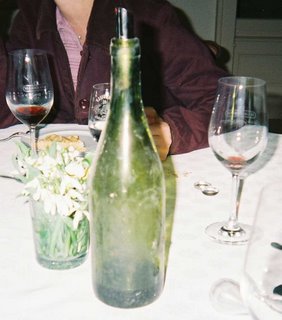Snowdrops
 I left for Umbria and Beaujolais on March 12 and I came back on March 20...the first day of spring. Before I left, I said good-bye to winter. To a freezing-cold house, a bleak yard, and a depressing litter-strewn street, which I know only too well since I have to walk the dog up and down it four times a day. I said I'd expect to see forsythia or crocuses or, at the very least, snowdrops upon my return.
I left for Umbria and Beaujolais on March 12 and I came back on March 20...the first day of spring. Before I left, I said good-bye to winter. To a freezing-cold house, a bleak yard, and a depressing litter-strewn street, which I know only too well since I have to walk the dog up and down it four times a day. I said I'd expect to see forsythia or crocuses or, at the very least, snowdrops upon my return.So I was excited to see snowdrops before I even got home. On Saturday night, in France, at Château Pierreux, at a lovely dinner hosted by Philippe Bardet of Mommessin. Well, not snowdrops growing, but little glasses of snowdrops as centerpieces, a row of them all down the impressively long table.
The common snowdrop is Galanthus nivalis; i.e., "white flower of the snow." It's the flower that, according to folklore, sprang up from the falling snowflakes to console Adam and Eve when they were driven out of the Garden of Eden into the cold, wintry world. The flower that Odysseus used as antidote to Circe's poisonous drugs. And the subject of one of Hans Christian Andersen's horrid little fairy tales, which I won't synopsize because they creeped me out as a child and still do.
From the common snowdrop is isolated an alkaloid called galantamine. Galantamine acts as an acetylcholinesterase inhibitor; that is, it helps maintain normal levels of the neurotransmitter acetylcholine. (Acetylcholine deficiency leads to Alzheimer's disease.) Galantamine is also used to treat headache, neuralgia, polio, and other neurological conditions and diseases.
Not a bad portfolio for such a dinky little flower.
And it was snowdrops, not out-of-season hothouse flowers or exotic blooms flown in from South America, giving the finishing touch to the couvert at a meal which was classy and casual as only the French can do it. We started our meal festively with a glass of crémant, followed by a fish mousse accompanied by a 2004 Monternot Pouilly-Fuissé, then Charolais beef and a gratin de pommes de terre dauphinois with a 2004 Brouilly, a 2003 Réserve du Château, and two dusty unlabelled bottles from the cellars--a 1990 and a 1989 Réserve du Château. Proof in the glass that good Beaujolais can be held. And a lovely, gracious gesture on the part of our host....there weren't too many of those bottles left down there!
This is one of those make-or-break years for me. And the first day of spring is the beginning of the year, for Persians anyhow. So I'm going to take the little glasses of snowdrops as omens of hope for the coming year. Relaxing in the Château Pierreux after a hard day of wine-tasting, raising a glass of crémant to Pamela Wittmann and Philippe Bardet, the air seemed full of promise. If the humble snowdrop could be chez soi, why not I?
Labels: beaujolais, flowers, food


3 Comments:
"Galantamine acts as an acetylcholinesterase inhibitor; that is, it helps maintain normal levels of the neurotransmitter acetylcholine. (Acetylcholine deficiency leads to Alzheimer's disease.)"
So presumably any intake of galantamine would be a very bad idea for someone with Alzheimer's, as it would inhibit the operation of a chemical that the patient is deficient in anyway.
The implication here, if I understand you, though, is that its possible to have both too much and too little of the stuff.
Just thinking aloud here. Keep up the good work.
If I follow you, I think you are confusing acetylcholine with acetylcholinesterase.
See:
www.alzheimers.org.uk/Research/Cure/drugs.htm:
"People with Alzheimer’s have low levels of a neurotransmitter called acetylcholine in their brain. Neurones which contain acetylcholine (cholinergic neurons) are found in an area of the brain called the basal nucleus, as well as in the nearby hippocampus, and the cerebral cortex – all areas involved in memory, learning and thinking. Circuits connecting these regions are powered by acetylcholine, and a lack of the neurotransmitter will impair these mental functions.
Donepezil (Aricept®), rivastigmine (Exelon®) and galantamine (Reminyl®) are acetylcholinesterase AChE inhibitors.
AChE is the enzyme that breaks down acetylcholine. Clinical trials show that these drugs can stabilise or improve cognition, global assessment scores, mood and behaviour in people with Alzheimer’s disease."
It is true that ACEs only slow the progression of the disease, don't cure it, and are not effective for advanced cases in which there are few cholinergic neurons.
My "implication," however, was simply that snowdrops are good for something.
"If I follow you, I think you are confusing acetylcholine with acetylcholinesterase."
Yes, that's exactly what I was doing. Thank you for pointing out my dim prospects for a career in neurochemistry.
Post a Comment
<< Home